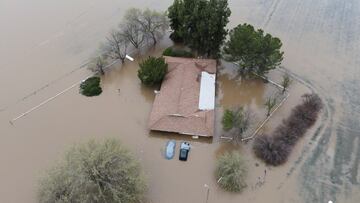California on alert for atmospheric river: Areas affected and how long it will last
More than 35 million people in California are under alert for another atmospheric river. Here are the affected areas and how long the alert will last.

The state of California, recently devastated by historic heavy winter storms, is again affected by another atmospheric river. More than 35 million people, comprising most of the state’s population, are under some form of weather alert.
“Many areas already exceeding two inches of rainfall for the storm thus far, and more showers are to come through Wednesday,” according to the National Weather Service. Several areas have also been issued a special marine warning because of potentially hazardous marine weather conditions.
Many areas already exceeding 2 inches of rainfall for the storm thus far, and more showers are to come through Wednesday.
— NWS Los Angeles (@NWSLosAngeles) March 22, 2023
Take a look at the updated rainfall totals: https://t.co/KeBvEHapBY#CAwx #LArain pic.twitter.com/yXj2As1yOw
Millions in California on Atmospheric River Alert: Areas affected and how long it will last
Strong winds, thunderstorms and showers have affected most of central and southern California. Meanwhile, in Los Angeles, weather authorities reported strong gusts of wind, warning that more heavy rains will arrive in the area during the coming hours.
Some of the adverse weather conditions are expected to continue Wednesday and then improve Thursday, according to an NWS update.
READ ALSO:
- Cases of ‘Candida auris’, a super-resistant fungus, are increasing in the US
- CDC warns against Candida Auris: what are the fungal infection symptoms?
- Florida man bitten by gator at his front door
Another significant weather event is impacting California. Sarah from @NWS has an update on what we can expect over the next couple days. Now's the time to ensure you and your family are prepared. pic.twitter.com/JdgVPeD3Hc
— California Governor's Office of Emergency Services (@Cal_OES) March 21, 2023
California officials warn against traveling
Meanwhile, state transportation authorities reported the presence of snow and wind in the mountains of Riverside and San Bernardino counties.
The California Department of Transportation advises residents to consider traveling when weather conditions have improved, and says that if they must travel, they should be prepared and stay safe.
California has recorded at least 12 atmospheric rivers this winter season alone, which has wreaked havoc on the weather in the state.
Storms have been battering California with strong winds and heavy rain. This is what it looked like earlier today as a severe storm was moving through San Diego, CA. #CAwx pic.twitter.com/xSCfiqqvNF
— WeatherNation (@WeatherNation) March 21, 2023
What is an atmospheric river?
According to the National Oceanic and Atmospheric Administration, atmospheric rivers are relatively long and narrow regions in the atmosphere that carry most of the water vapor out of the tropics.
These corridors of moisture are called rivers in the sky because they transport large amounts of water vapor across vast distances. At times they can move more than ten times the flow of the Amazon River.
Related stories
These vapor columns move with the weather, and when atmospheric rivers make landfall, they often release this water vapor in the form of rain or snow, and sometimes cause weather-related disasters such as flooding and landslides.
However, atmospheric rivers also serve the important function of providing significant amounts of precipitation to areas that typically experience dry weather such as California and other parts of western United States. Some of these regions are heavily dependent on atmospheric rivers for their water supply.
California's extreme weather in the past few months is bringing joy to some — and misery to others: pic.twitter.com/JMwRol0S3q
— DW News (@dwnews) March 21, 2023

